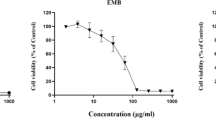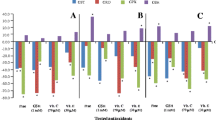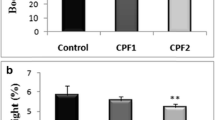Abstract
Insecticides and their residues are known to cause several types of ailments in human body. An attempt had been made to assess digitally the geno-toxicity of methyl parathion (MP) and chlorpyrifos (CP) to in vitro-grown HepG2 cell line, with Hoechst 33342 staining, comet, and micronucleus assays. Additionally, “acridine orange/ethidium bromide” (AO/EB) staining was done for the determination of insecticide-induced cytotoxicity, in corollary. Hoechst 33342 staining of cells revealed a decrease in live cell counts at 8–40 mg/L MP and 15–70 mg/L CP. Moreover, nuclear fragmentations in ranges 8 to 40 mg/L MP and 15 to 70 mg/L CP were recorded dependant on individual doses, increasingly with concomitant increases in comet tail length values. DNA fragmentation index measured in comet assays was 94.3 ± 0.57 at 40 mg/L MP and 93.3 ± 2.08 at 70 mg/L CP. Average micronuclei number was 59.0 ± 2.00 at 40 mg/L MP and 62.6 ± 1.52 at 70 mg/L CP, per 1000 cell nuclei, in micronucleus assay. Minimum inhibitory concentration (MIC) values with AO/EB staining for monitoring cytotoxicity were 4 and 10 mg/L for MP and CP, respectively. Lethal concentration50 (LC50) values were 20.89 mg/L MP and 79.43 mg/L CP in AO/EB staining, for cytotoxicity with probit analyses. It was concluded that MP was comparatively more geno-toxic than CP to HepG2 cell. It was discernible that at lower levels of each insecticide, geno-toxicity was recorded in comparison to cytotoxicity.






Similar content being viewed by others
References
Aldridge JE, Meyer A, Seidler FJ, Slotkin TA (2005) Alterations in central nervous system serotonergic and dopaminergic synaptic activity in adulthood after prenatal or neonatal chlorpyrifos exposure. Environ Health Perspect 113:1027–1031
Ali D, Nagpure NS, Kumar S, Kumar R, Kushwaha B (2008) Genotoxicity assessment of acute exposure of chlorpyrifos to freshwater fish Channa punctatus (Bloch) using micronucleus assay and alkaline single-cell gel electrophoresis. Chemosphere 71:1823–1831
ATSDR (1999) Toxicological profile for methyl parathion. Draft for public comment. Atlanta, GA, US Department of Health and Human Services, Public Health Service, Agency for Toxic Substances and Disease Registry
Bai Y, Ling Z, Wang J (2006) Organophosphorus pesticide residues in market foods in Shaanxi area, China. Food Chem 98:240–242
Betarbet R, Sherer TB, MacKenzie G, Garcia-Osuna M, Panov AV, Greenamyre JT (2000) Chronic systemic pesticide exposure reproduces features of Parkinson’s disease. Nat Neurosci 3:1301–1306
Chidiebere U, Ambali SF, Ayo JQ, Eseivo KAN (2011) Acetyl-L-carnitine attenuates haemotoxicity induced by subacute chlorpyrifos exposure in Wistar rats. Der Pharmacia Lettre 3:292–303
Chowdhury MA, Jahan I, Karim N, Alam MK, Abdur Rahman M, Moniruzzaman M, Gan SH, Fakhruddin AN (2014) Determination of carbamate and organophosphorus pesticides in vegetable samples and the efficiency of gamma-radiation in their removal. Biomed Res Int. doi:10.1155/2014/145159
Dubrez L, Savoy I, Hamman A, Solary E (1996) Pivotal role of a DEVD-sensitive step in etoposide-induced and Fas-mediated apoptotic pathways. EMBO J 15:5504–5512
Edwards FL, Yedjou CG, Tchounwou PB (2013) Involvement of oxidative stress in methyl parathion and parathion-induced toxicity and geno-toxicity to human liver carcinoma (HepG2) cells. Environ Toxicol 28:342–348
Farag AT, Radwan AH, Sorour F, El Okazy A, ElAgamy E-S, ElSebae A-K (2010) Chlorpyrifos induced reproductive toxicity in male mice. Reprod Toxicol 29:80–85
Furlong CE, Holland N, Richter RJ, Bradman A, Ho A, Eskenazi B (2006) PON1 status of farmworker mothers and children as a predictor of organophosphate sensitivity. Pharmacogenet Genomics 16:183–190
Gasnier C, Dumont C, Benachour N, Clair E, Chagnon MC, Seralini GE (2009) Glyphosate based herbicides are toxic and endocrine disruptors in human cell lines. Toxicology 262:184–191
Gilbert PM, Havenstrite KL, Magnusson KE, Sacco A, Leonardi NA, Kraft P, Nguyen NK, Thrun S, Lutolf MP, Blau HM (2010) Substrate elasticity regulates skeletal muscle stem cell self-renewal in culture. Science 329:1078–1081
Grimsrud TK, Andersen A (2010) Evidence of carcinogenicity in humans of water-soluble nickel salts. J Occup Med Toxicol 8:5–7
Hosseinimehr SJ, Shafaghati N, Hedayati M (2013) Genotoxicity induced by iodine-131 in human cultured lymphocytes. Interdiscip Toxicol 6:74–76
Hreljac I, Zajc I, Lah T, Fililic M (2008) Effects of model organophosphorous pesticides on DNA damage and proliferation of HepG2 cells. Environ Mol Mutagen 49:360–367
Khalil AM (2015) Toxicological effects and oxidative stress responses in freshwater snail, Lanistes carinatus, following exposure to chlorpyrifos. Ecotoxicol Environ Saf 116:137–142
Kirkland DJ, Aardema M, Banduhn N, Carmichael P, Fautz R, Meunier JR, Pluhler S (2007) In vitro approaches to develop weight of evidence (WoE) and mode of action (MoA) discussion with positive in vitro genotoxicity results. Mutagenesis 22:161–175
Kirsch-Volders M, Sofuni T, Aardema M, Albertini S, Eastmond D, Fenech M, Jr IM, Lorge E, Norppa H, Surralles J, von der Hude W, Wakata A (2000) Report from the in vitro micronucleus assay working group. Environ Mol Mutagen 35:167–172
Knasmuller S, Mersh-Sundermann V, Kevekordes S, Darroudi F, Huber WW, Hoelzl C, Bichler J, Majer BJ (2004) Use of human-derived liver cell lines for the detection of environmental and dietary genotoxicants; current state of knowledge. Toxicology 198:315–328
Lee WJ, Sandler DP, Blair A, Samanic C, Cross AJ, Alavanja MC (2007) Pesticide use and colorectal cancer risk in the agricultural health study. Int J Cancer 121:339–346
Mallatou H, Pappas CP, Kondyli E, Albanis TA (1997) Pesticide residues in milk and cheeses from Greece. Sci Total Environ 196:111–117
Marasinghe J, Yu Q, Connell D (2014) Assessment of health risk in human populations due to chlorpyrifos. Toxics 2:92–114
Mattson JL, Wilmer JW, Shankar MR, Berdasco NM, Crissman JW, Maurissen JP, Bond DM (1996) Single dose and 13-week repeated-dose neurotoxicity screening studies of chlorpyrifos. Food Chem Toxicol 34:393–405
Melgar MJ, Santaeufemia M, Garcia MA (2010) Organophosphorus pesticide residues in raw milk and infant formulas from Spanish northwest. J Environ Sci Health B 45:595–600
Mircioiu C, Voicu VA, Ionescu M, Miron DS, Radulescu FS, Nicolescu AC (2013) Evaluation of in vitro absorption, decontamination and desorption of organophosphorous compounds from skin and synthetic membranes. Toxicol Lett 219:99–106
Nair R, Singh VJ, Salian SR, Kalthur SG, D’Souza AS, Shetty PK, Mutalik S, Kalthur G, Adiga SK (2014) Methyl parathion inhibits the nuclear maturation, decreases the cytoplasmic quality in oocytes and alters the developmental potential of embryos of Swiss albino mice. Toxicol Appl Pharmacol 279:338–350
Nakadai A, Li Q, Kawada T (2006) Chlorpyrifos induces apoptosis in human monocyte cell line U937. Toxicology 224:202–209
Ojha A, Yaduvanshi SK, Pant SC, Lomash V, Srivastava N (2013) Evaluation of DNA damage and cytotoxicity induced by three commonly used organophosphate pesticides individually and in mixture, in rat tissues. Environ Toxicol 28:543–552
Patnaik R, Padhy RN (2015) Cellular and nuclear toxicity of HgCl2 to in vitro grown lymphocytes from human umbilical cord blood. Proc Natl Acad Sci India Sect B Biol Sci 85:821–830
Plant N (2004) Strategies for using in vitro screens in drug metabolism. Drug Discov Today 9:328–336
Rath S, Sahu MC, Dubey D, Debata NK, Padhy RN (2011) Which value should be used as the lethal concentration 50 (LC50) with bacteria? Interdiscip Sci: Comput Life Sci 3:138–143
Rosler ES, Fisk GJ, Ares X, Irving J, Miura T, Rao MS, Carpenter MK (2004) Long-term culture of human embryonic stem cells in feeder-free conditions. Dev Dyn 229:259–274
Sakellarides TM, Siskos MG, Albanis TA (2003) Photodegradation of selected organo-phosphorus insecticides under sunlight in different natural waters and soils. Int J Environ Anal Chem 83:33–50
Sandhu MA, Saeed AA, Khilji MS (2013) Genotoxicity evaluation of chlorpyrifos: a gender related approach in regular toxicity testing. J Toxicol Sci 38:237–244
Sanghi R, Pillai MKK, Jayalekshmi TR, Nair A (2003) Organochlorine and organophosphorous pesticide residues in breast milk from Bhopal, Madhya Pradesh, India. Hum Exp Toxicol 22:73–76
Sapbamrer R, Hongsibsong S (2014) Organophosphorus pesticide residues in vegetables from farms, markets, and a supermarket around Kwan Phayao Lake of Northern Thailand. Arch Environ Contam Toxicol 67:60–67
Slotkin TA, Levin ED, Seidler FJ (2006) Comparative developmental neurotoxicity of organophosphate insecticides: effects on brain development are separable from systemic toxicity. Environ Health Perspect 114:746–751
Srivastava S, Narvi SS, Prasad SC (2011) Levels of select organophosphates in human colostrum and mature milk samples in rural region of Faizabad district, Uttar Pradesh, India. Hum Exp Toxicol 30:1458–1463
Tabassum N, Rafique U, Balkhair KS, Ashraf MA (2014) Chemodynamics of methyl parathion and ethyl parathion: adsorption models for sustainable agriculture. Biomed Res Int. doi:10.1155/2014/831989
Tariq MI, Afzal S, Hussain I (2004) Pesticides in shallow groundwater of Bahawalnagar, Muzafargarh, DG Khan and Rajan Pur districts of Punjab, Pakistan. Environ Int 30:471–479
Tice RR, Agurell E, Anderson D et al (2000) Single cell gel/comet assay: guidelines for in vitro and in vivo genetic toxicology testing. Environ Mol Mutagen 35:206–221
Tryfonos M, Papaefthimiou C, Antonopoulou E, Theophilidis G (2009) Comparing the inhibitory effects of five protoxicant organophosphates (azinphos-methyl, parathion-methyl, chlorpyriphos-methyl, methamidophos and diazinon) on the spontaneously beating auricle of Sparus aurata: an in vitro study. Aqua Toxicol 94:211–218
Tzimas G, Thiel R, Chahoud I, Nau H (1997) The area under the concentration–time curve of all-trans-retinoic acid is the most suitable pharmacokinetic correlate to the embryo toxicity of this retinoid in the rat. Toxicol Appl Pharmacol 143:436–444
Uzunhisarcikli M, Kalender Y (2011) Protective effects of vitamins C and E against hepatotoxicity induced by methyl parathion in rats. Ecotoxicol Environ Saf 74:2112–2118
Westerink WM, Schoonen WG (2007) Cytochrome P450 enzyme levels in HepG2 cells and cryopreserved primary human hepatocytes and their induction in HepG2 cells. Toxicol In Vitro 21:1581–1591
Whyatt RM, Rauh V, Barr DB, Camann DE, Andrews HF, Garfinkel R, Hoepner LA, Diaz D, Dietrich J, Reyes A, Tang D, Kinney PL, Perera FP (2004) Prenatal insecticide exposures and birth weight and length among an urban minority cohort. Environ Health Perspect 112:1125–1132
Wu J, Lin L, Luan T, Chan Gilbert YS, Lan C (2007) Effects of organophosphorus pesticides and their ozonation byproducts on gap junctional intercellular communication in rat liver cell line. Food Chem Toxicol 45:2057–2063
Acknowledgments
R Patnaik is an INSPIRE fellow (IF 120548) from Department of Science & Technology, Govt. of India, New Delhi. Cell culture facilities were provided by Prof. Dr. MR Nayak, President, Siksha ‘O’ Anusandhan University, Bhubaneswar.
Author information
Authors and Affiliations
Corresponding author
Additional information
Responsible editor: Philippe Garrigues
Rights and permissions
About this article
Cite this article
Patnaik, R., Padhy, R.N. Evaluation of geno-toxicity of methyl parathion and chlorpyrifos to human liver carcinoma cell line (HepG2). Environ Sci Pollut Res 23, 8492–8499 (2016). https://doi.org/10.1007/s11356-015-5963-8
Received:
Accepted:
Published:
Issue Date:
DOI: https://doi.org/10.1007/s11356-015-5963-8




